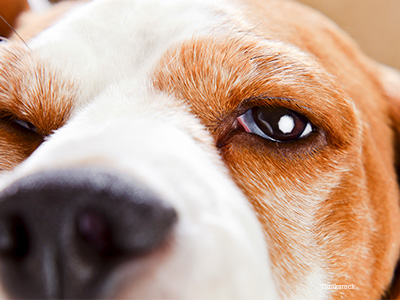The purpose of the eyelids is simply to protect the eye from local injury. Though their function is simple the anatomy of the eyelid is complicated and is made up of layers of skin, muscle and mucus membrane. The tissues incorporate nerves and blood vessels, oil glands, hair follicles and secondary tear glands. All of these tissues are susceptible to injury, infection and benign or malignant tumors.
 Types of tumors
Types of tumors
Tumors of the eyelid are the most common tumors of the eye associated tissues and can originate from any of the tissues of the lid. Adenomas (benign tumor) and adenocarcinomas (gland cancer) of the oil glands are the most common1.
Older dogs commonly develop eyelid tumors. Meibomian adenocarcinomas (glands), melanomas and squamous cell carcinomas (skin) are malignant and are treated by wide surgical removal1. Other frequent eyelid tumors include:
- Histiocytoma (benign skin tumor)
- Mastocytoma (mast cell tumor)
- Papilloma (benign epithelial tumor)
Fortunately, eyelid tumors in dogs are usually benign and do not spread to distant tissues. Surgical removal cures most tumors of the eyelid but complete removal sometimes can cause eyelid deformities1. Eyelid tumors can become quite large and be very disfiguring. Untreated eyelid tumors, even benign ones, can grow so large as to interfere with eyelid function.
Eyelid tumor treatment
Treatment consists of removal by surgery or by freezing with liquid nitrogen, which should be performed sooner than later.
Prognosis of eyelid tumors
Surgical removal or freezing are usually successful and recurrence of an individual tumor is unlikely – there is typically an 85-90% chance of a tumor not returning2.
Prevention of eyelid tumors
The cause of most eyelid tumors is unknown but some, like squamous cell carcinoma, are associated with excess exposure to sunlight. Some breeds seem to be predisposed to the development of sebaceous (gland) tumors. Though there may be no preventive measures one can take, early treatment can prevent severe complications and reduce the cost of treatment.
Because eyelid tumors occur most often in older dogs, it is common for pet guardians to procrastinate -- “We will just watch it and see what happens.” Unfortunately, as we wait, it is likely that the mass will grow and become more inflamed. As it grows it will become progressively more difficult to remove.
Consult with your veterinarian if you see any early signs.
Questions for your veterinarian
- My dog has a small growth on her eyelid. Could it be cancer?
- I am concerned about an ulcerated mass on my dog’s eyelid. It is so close to the eye. Can it be removed?
If you have any questions or concerns, you should always visit or call your veterinarian -- they are your best resource to ensure the health and well-being of your pets.
Resources:
- "Ocular Neoplasia in Dogs." The Merck Veterinary Manual. Web.
- McCalla, Terri L., DVM, MS, DACVO. "Canine Eyelid Diseases." Animal Eye Care LLC. Web.
